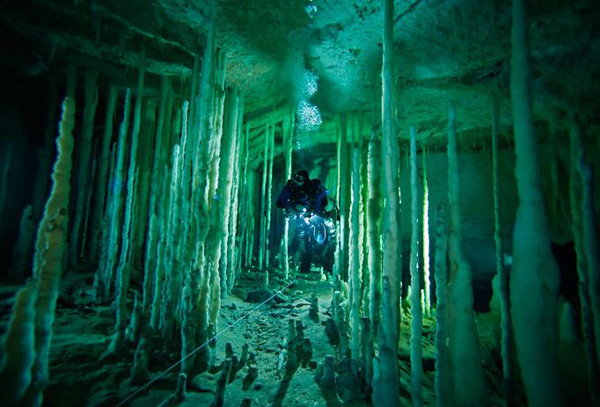|
From:TheBahamasWeekly.com Abaco
(National Geographic) The blue holes of the Bahamas yield a scientific trove that may even shed light on life beyond Earth. If only they weren’t so dangerous to explore. We sink into Stargate, sweeping the void with our dive lights. Fifty feet from the surface looms a pale haze, less smoky than fibrous, like a silvery net of faint, swirling cobwebs hovering motionless in the darkness. It's a layer of hydrogen sulfide, a toxic gas created by bacterial colonies and decaying organic matter. Divers entering the gas may experience itching skin, tingling, or dizziness; some smell rotten eggs as it penetrates their skin and metabolizes through their lungs. The gas density in Stargate is relatively low, but I'm struck by a wave of nausea as we descend. I glance at my guide, Brian Kakuk—one of the world's foremost cave divers. He appears unfazed. My head begins to throb; clearly, I'm unusually sensitive to the toxin. In the epic poem Beowulf, "dim serpent shapes" in the depths guard the lake of Grendel and his mother, shielding their lair. The otherworldly mist in Stargate appears to serve a similar role—a poisonous curtain that protects the deeper reaches of the cave. Offshore flooded caves, so-called ocean blue holes, are extensions of the sea, subject to the same heavy tides and host to many of the same species found in the surrounding waters. Inland blue holes, however, are unlike any other environment on Earth, thanks largely to their geology and water chemistry. In these flooded caves, such as Stargate on Andros Island, the reduced tidal flow results in a sharp stratification of water chemistry. A thin lens of fresh water—supplied by rainfall—lies atop a denser layer of salt water. The freshwater lens acts as a lid, isolating the salt water from atmospheric oxygen and inhibiting bacteria from causing organic matter to decay. Bacteria in the zone just below the fresh water survive by exploiting sulfate (one of the salts in the water), generating hydrogen sulfide as a by-product. Known on land as swamp or sewer gas, hydrogen sulfide in higher doses can cause delirium and death. Read MORE Photo Gallery
|
